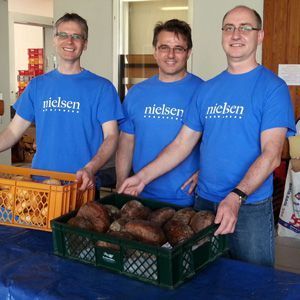
When I think about fighting hunger, I think about how I can help out in my local community. I’m also excited by some of the large scale progress like the Global Food Security Act which Congress recently passed. Then I think about the unique work we do at Nielsen, leveraging data and insights to better understand our world.
While hunger in America continues to be an issue, using data is part of our collective efforts to make an impact. In the 2016 Map the Meal Gap, Nielsen partnered with Feeding America to understand not just what hunger looks like at the county level in the U.S., but also to gain a better understanding of the impact of hunger on our communities. Map the Meal Gap puts dollars on the data, exposing everything from what people facing hunger spend on meals to what they need to close their food-budget shortfall.
Whatever hat(s) we wear as individuals, community members or representatives in the public, private or civic sectors -- my hope is that we can continue to find new and innovative ways to mobilize data to make a difference. By expanding our understanding of the key challenges we face, we can use data to find new and innovative solutions to fight hunger in America. Anti-hunger advocates and food banks are on the front lines of this, serving individuals and families in need every day. From this year’s study, here are some of the data points that I hope will spur action and ignite change:
- Food insecurity exists in every county in America. Overall food insecurity ranges from a low of 4 percent of the population in Loudoun County, Virginia up to 38 percent in Jefferson County, Mississippi, while Los Angeles County, California has the highest number of food-insecure individuals (1.4 million).
- In virtually all 3,142 counties, there are at least some food-insecure individuals whose level of income prevents them from qualifying for federal nutrition assistance. In 115 counties, including such populous ones as Collin County, TX and Montgomery County, PA, a majority of food-insecure individuals are likely ineligible for such assistance.
- The “Food Budget Shortfall” – the additional dollars food-insecure Americans report needing to meet their food needs – was $24.6 billion in 2014, an increase of $300 million from 2013 and the highest reported need since 2010.
At Nielsen, we use our data and insights to help nonprofits like Feeding America further their impact. Whether it's through hands-on or skills-based volunteering, or the in-kind giving of our data and services, we believe in the power of data to make an impact. For us, that impact is powered by our people and supported by our data.
To tackle hunger in the U.S., I continue to believe that no one organization or individual can fight hunger alone; we all must play a part. With each new release of Map the Meal Gap, I'm energized by the power of data, but humbled by the potential of our shared interest to truly change our world.
*Crystal Barnes is the vice president of corporate social responsibility at Nielsen. Nielsen provides pro bono support for Feeding America through skills-based volunteering and the in-kind donation of its data and insights.

